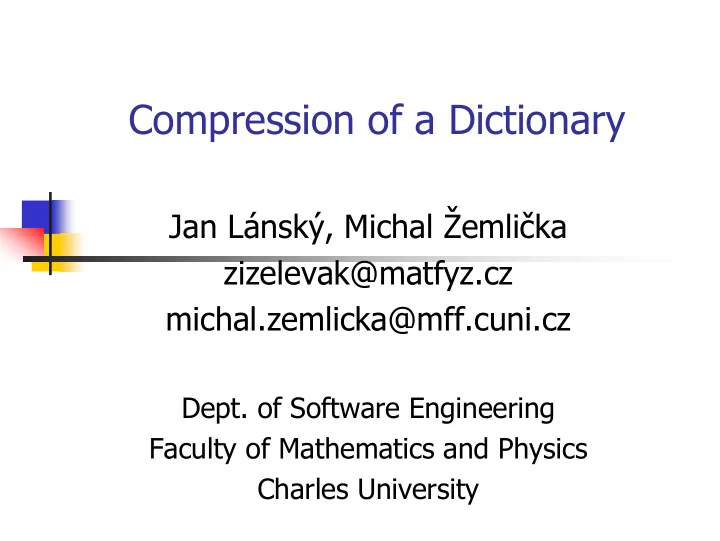

Compression of a Dictionary Jan Lánský, Michal Žemli č ka zizelevak@matfyz.cz michal.zemlicka@mff.cuni.cz Dept. of Software Engineering Faculty of Mathematics and Physics Charles University
Synopsis � Introduction � Existing methods � Trie-based methods � Results � Conclusion
Introduction Why we are compressing a dictionary ?
Large Alphabet Compression � Text Files - Compression over alphabet of words or syllables. � Alphabet (Dictionary) must be transferred with the coded message � Word-based methods � Moffat 1989 � Syllable-based methods � Lánský, Žemli č ka 2005
Influence of File Size � Large files � Dictionary takes small part of message � Influence of compression of the dictionary on compression ratio is small � Small files � Dictionary takes large part of message � Influence of compression of the dictionary on compression ratio is large
Existing methods Common used methods for compression of a dictionary of words or syllables
Character by Character (CD) � Code of string is composed from � Code of string type � Moffat: 2 types of words (word, non-word) � Lánský, Žemli č ka: 5 types of syllables � Encoded length of the string � Symbol codes
Character by Character (CD) � Examples � code(" to ") = codeType( lower ), codeLength( 2 ), codeLower(' t '), codeLower(' o ') � code(" 153 ") = codeType( numeric ), codeLength( 3 ), codeDigit(' 1 '), codeDigit(' 5 '), codeDigit(' 3 ')
External Compression � All strings from dictionary are concatenated by using separator � This resulting string is compressed by � LZW (we denote LZWD) � Bzip2 (we denote bzipD) � ...
Trie-based methods TD1, TD2, TD3 Compression of a dictionary using its structure
Dictionary � Data structure trie � Nodes may represent strings � Father represents a prefix of its sons � Mapping between strings and its order is unique in whole dictionary � Order is obtained during compression
Trie data structure � For each node we know � Whether a node represents a string ( represents ) � Number of sons ( count ) � Array of sons ( son ) � Extension of each son ( extension )
TD1 - encoding � EncodeTD1 () � EncodeGamma number of sons count � Encode represents ( bit 0 or 1) � For each son s � Distance = s .extension – previous( s ).extension � EncodeDelta(Distance) � EncodeNode( s )
TD1 - Example � ... Code node ' C ': � Code(1) – count � Bit(1) – repr. � Code(67-0) – dist � Code node ' M ' ... � Dictionary: "the", "to", "ACM", "AC", ".\n "
TD2 - Improvement � In TD1 version the distances between sons are coded. � Distances are calculated according binary values of the extending symbols � These distances are encoded by Elias delta coding representing � smaller numbers by shorter codes � larger numbers by longer codes. � Goal – decrease distances
TD2 - Improvement � Reordering alphabet � Primary according symbol type � Secondary according symbol frequency � 0-27 lower-case letter, 28-53 upper-case letters, 54-63 digits, 64-255 other symbols � TD2 - Distances between sons are counting in this new alphabet � TD2 gives shorter distances and its codes
� ... Code node ' C ': � Code(1) – count TD2 - Example � Bit(1) – repr. � Code(34-0) – dist � Code node ' M ' ... � Dictionary: "the", "to", "ACM", "AC", ".\n "
TD3 - Improvement � 5 types of words and syllables � Lower ("hour") � Upper ("HOUR") � Mixed ("Hour") � Numeric ("123") � Other ("???") � After coding 1-2 symbols from a string we can determine its type and improve its coding � 2 symbols per Mixed/ Upper, 1 symbol otherwise
TD3 - Improvement � Function first � First(lower-case letter) = 0 � First(upper-case letter) = 28 � First(digit) = 54 � First(other) = 64 � TD3 – if we know the type of the string, we decrease the distance of the first son by the value of function first for the son extension
� ... Code node ' M ': � Code(1) – count TD3 - Example Bit(1 ) – repr � Bit(1 Bit(1) ) – – repr repr. � � � Code(33-28-0) – dist � Return to node ' C ' ... � Dictionary: "the", "to", "ACM", "AC", ".\n "
Results Comparison of TD1, TD2, TD3, CD, LZWD and BzipD on dictionaries of words and syllables in Czech, English and German
Results - syllables
Results - syllables � TD3 outperforms other methods on all languages and file sizes � Syllables are short � Trie of syllables is dense � Example � 10Kb Czech file � 770 bytes of dictionary by TD3 � 1540 bytes of dictionary by CD (second best)
Results - words
Results - words � Czech � On 50kB and larger files is TD3 best � Long words, dense trie of words � English � On 200kB and larger files is TD3 best � Short words, quite dense trie of words � German � On 2MB and larger files is TD3 best � Long words, quite sparse trie of words
Results - words � How are methods succesfull on? � Smaller files � 1. CD, 2.-3.TD3, 2.-3. BzipD, 4. LZWD � Middle-sized files � 1. BzipD, 2. TD3, 3. CD, 4. LZWD � Larger files � 1. TD3, 2. BzipD, 3. CD, 4. LZWLD
Conclusion On what types of dictionaries is TD3 good ?
Conclusion � Where is TD3 successful � Dense tries with short string � Dictionaries of syllables � Larger dictionaries of words � TD3 is not bad on other types of dictionaries � TD3 is usually at least the second best method
Recommend
More recommend